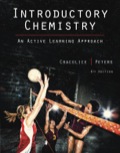
Concept explainers
Interpretation:
A brief description of the relationships among each of the following groups of terms or phrases is to be written
Atom, molecule, formula unit
Concept introduction:
The principles of chemistry deal with the study of substances and the energy related with their change. Usually, the mass associated with everything is referred as matter. Moreover, matter can be viewed as macroscopic and microscopic samples. The view point of matter at particulate level is tiny to observe, models are generally used to represent particles. In common, chemists use models of atom and molecules to represent tiny particles based on experimental data. Commonly, the chemical compounds are made up of polyatomic ions and the ratio of positive to negative ions present in the substance is expressed as formula of ionic compound.
Want to see the full answer?
Check out a sample textbook solution
Chapter 6 Solutions
Introductory Chemistry: An Active Learning Approach
- Which of the following statements about compounds is TRUE? A substance that cannot be broken down into simpler substances. A pure substance that has variable composition throughout. A substance that is not as common as pure elements. A substance composed of two or more elements in fixed, definite proportions. none of the abovearrow_forwardWhich of the following is a property of ionic compounds? Solids may be soft, waxy, or flexible. OAt ambient temperature, they may be a solid, liquid, or gas. They have a relatively low melting point. They conduct electricity when dissolved in water.arrow_forwardWhich of the following compounds is most likely to have parentheses as part of its chemical formula? O zinc peroxide sulfur hexafluoride O mercury (I) hydrogen phosphate O aluminum cyanidearrow_forward
- The difference between organic and inorganic in chemistry?arrow_forwardDifferentiate between organic and inorganic compounds?arrow_forwardFor each of the following pairs of compounds, describe a simple chemical or physical test to distinguish between them, stating specific observations.arrow_forward
- < Complete the table below by writing the symbols for the cation and anion that make up each ionic compound. The first row has been completed for you. ionic compound cation NaCl Ni(OH)₂ (NH₂)₂0 Na 0 0 MnCl₂ 0 v₂(SO₂), 0 anion Cl 0 0 0 5arrow_forwardTwo or more substances in variable proportions, where the composition is constant throughout are a compound. an element. a heterogeneous mixture. a homogeneous mixture. a crystalline solid.arrow_forwardClassify the statements pertaining to elements and compounds as either true or false. True False Compounds must contain at least [wo elements. Compounds are pure substances whereas elements are mixtures Compounds cannot be broken down further by processes such as filtration. Compounds may be broken down into simpfer substances through: chemical processes. A compound is a physical mixture of simpler substances.arrow_forward
- Write the chemical formula for each of the following compounds. vitamin A: 20 carbon, 30 hydrogen, and 1 oxygen atom vitamin K: 31 carbon, 46 hydrogen, and 2 oxygen atomsarrow_forwardWater and sodium chloride are both considered substances as well as compounds, but water exists as molecules while sodium chloride does not. (i) Explain this difference in the behavior of water and sodium chloride. As part of your explanation, (ii) define the terms substance, molecule, and compound.arrow_forwardWhich of the following is not true about diatomic molecules? O They are all liquids at room temperature. O They exist as two bonded atoms. O All of the other answers are true. O Chlorine is a diatomic molecule. Hydrogen is a diatomic molecule.arrow_forward
 Introductory Chemistry: An Active Learning Approa...ChemistryISBN:9781305079250Author:Mark S. Cracolice, Ed PetersPublisher:Cengage Learning
Introductory Chemistry: An Active Learning Approa...ChemistryISBN:9781305079250Author:Mark S. Cracolice, Ed PetersPublisher:Cengage Learning Chemistry: The Molecular ScienceChemistryISBN:9781285199047Author:John W. Moore, Conrad L. StanitskiPublisher:Cengage Learning
Chemistry: The Molecular ScienceChemistryISBN:9781285199047Author:John W. Moore, Conrad L. StanitskiPublisher:Cengage Learning Chemistry: Principles and PracticeChemistryISBN:9780534420123Author:Daniel L. Reger, Scott R. Goode, David W. Ball, Edward MercerPublisher:Cengage Learning
Chemistry: Principles and PracticeChemistryISBN:9780534420123Author:Daniel L. Reger, Scott R. Goode, David W. Ball, Edward MercerPublisher:Cengage Learning- Chemistry: Matter and ChangeChemistryISBN:9780078746376Author:Dinah Zike, Laurel Dingrando, Nicholas Hainen, Cheryl WistromPublisher:Glencoe/McGraw-Hill School Pub Co
 General Chemistry - Standalone book (MindTap Cour...ChemistryISBN:9781305580343Author:Steven D. Gammon, Ebbing, Darrell Ebbing, Steven D., Darrell; Gammon, Darrell Ebbing; Steven D. Gammon, Darrell D.; Gammon, Ebbing; Steven D. Gammon; DarrellPublisher:Cengage Learning
General Chemistry - Standalone book (MindTap Cour...ChemistryISBN:9781305580343Author:Steven D. Gammon, Ebbing, Darrell Ebbing, Steven D., Darrell; Gammon, Darrell Ebbing; Steven D. Gammon, Darrell D.; Gammon, Ebbing; Steven D. Gammon; DarrellPublisher:Cengage Learning Introductory Chemistry: A FoundationChemistryISBN:9781337399425Author:Steven S. Zumdahl, Donald J. DeCostePublisher:Cengage Learning
Introductory Chemistry: A FoundationChemistryISBN:9781337399425Author:Steven S. Zumdahl, Donald J. DeCostePublisher:Cengage Learning





